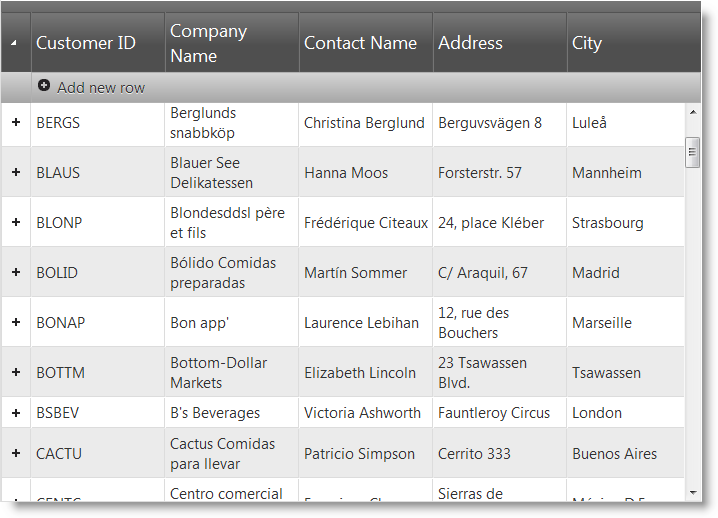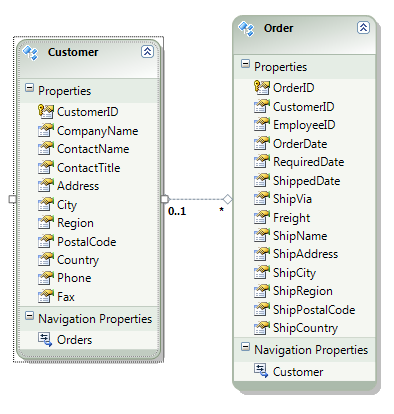This topic will explain how to bind the igHierarchicalGrid™ to a Web API Service.
The following list includes links to topics useful as background information for understanding this topic.
This topic contains the following sections:
Binding the igHierarchicalGrid to an MVC4 Web API is a two stage process:
By default, Web API supports JSON, XML, and form-url-encoded data serialization. The $.ig.RESTDataSource supports JSON serialization by default. JSON is used in this example.
Following are the general requirements for binding to an ASP.NET MVC 4 Web API.
Following are the general conceptual steps for binding to an ASP.NET MVC 4 Web API.
1. Setup the model
This sample explains how to bind the igHierarchicalGrid in load-on-demand mode. REST settings are shown using the default non-batch mode.
The example is using data from the Customers and Orders tables of the Northwind database.
The following screenshot is a preview of the final result.

To complete the procedure, you need the following:
The following steps demonstrate how to bind igHierarchicalGrid to MVC 4 Web API.
Create the project
Add a reference to the Infragistics.Web.Mvc.dll
Infragistics.Web.Mvc.dll from the .NET tab or alternatively Browse for it.Add reference to Ignite UI for jQuery Scripts
_Layout.cshtml file under the Views\Shared folder add the reference to Infragistics loaderIn HTML:
<script src="../../Scripts/jquery-1.6.2.js" type="text/javascript"></script>
<script src="../../Scripts/jquery-ui-1.8.11.js" type="text/javascript"></script>
<script type="text/javascript" src="../../Scripts/Infragistics/js/infragistics.loader.js"></script>
In the _Layout.cshtml file under Views\Shared folder delete the following lines
In C#:
@Scripts.Render("~/bundles/modernizr")
@Scripts.Render("~/bundles/jquery")
Add an ADO.NET Entity Data Model for the Customers and Orders tables in the Northwind Database and name it NorthwindModel.

You only need a subset of the Customer and Order fields so create separate classes which hold only the data needed for this example.
Customer classCustomer.csAdd the following properties to the Customer.cs file:
In C#:
public class Customer
{
public string CustomerID { get; set; }
public string CompanyName { get; set; }
public string ContactName { get; set; }
public string Address { get; set; }
public string City { get; set; }
public List<Order> Orders { get; set; }
}
Order classOrder.csIn C#:
public class Order
{
public int OrderID { get; set; }
public string ShipName { get; set; }
public string ShipAddress { get; set; }
}
Replace the Index action method with the following code:
In C#:
public ActionResult Index()
{
NorthwindModel.NorthwindEntities db = new NorthwindModel.NorthwindEntities();
var customers = from c in db.Customers
select new Customer() { CustomerID = c.CustomerID, CompanyName = c.CompanyName, ContactName = c.ContactName, City = c.City, Address = c.Address };
return View(customers.AsQueryable());
}
To configure load-on-demand in the Index action method, define which root layout is bound to the Customers data and which child layout is bound to the Orders data. Enable REST support by setting the Rest property to true. Also, define the RestSettings property and the Updating feature.
Define a strongly typed model
In C#:
@model IQueryable<igHierarchicalGridRESTSample.Models.Customer>
Reference the Infragistics.Web.Mvc.dll assembly
In C#:
@using Infragistics.Web.Mvc
Define the Infragistics loader
In C#:
@Html.Infragistics().Loader().ScriptPath("~/Scripts/Infragistics/js/").CssPath("~/Scripts/Infragistics /css/").Render()
Note: You must change the
ScriptPathandCssPathto match your Ignite UI for jQuery file locations.
Define the grid:
In C#:
@(Html.Infragistics().Grid(Model).
ID("grid1").
AutoGenerateColumns(false).
AutoGenerateLayouts(false).
Height("500px").
Width("700px").
ResponseDataKey(String.Empty).
PrimaryKey("CustomerID").
LoadOnDemand(true).
Rest(true).
Columns(column =>
{
column.For(x => x.CustomerID).HeaderText("Customer ID").DataType("string");
column.For(x => x.CompanyName).HeaderText("Company Name").DataType("string");
column.For(x => x.ContactName).HeaderText("Contact Name").DataType("string");
column.For(x => x.Address).HeaderText("Address").DataType("string");
column.For(x => x.City).HeaderText("City").DataType("string");
}).
ColumnLayouts(layouts => {
layouts.For(x => x.Orders).
ResponseDataKey(String.Empty).
Width("100%").
ForeignKey("CustomerID").
PrimaryKey("OrderID").
AutoGenerateColumns(false).
AutoGenerateLayouts(false).
Columns(childcolumn =>
{
childcolumn.For(x => x.OrderID).HeaderText("Order ID").DataType("number");
childcolumn.For(x => x.ShipAddress).HeaderText("Ship Address").DataType("string");
childcolumn.For(x => x.ShipName).HeaderText("Ship Name").DataType("string");
}).Features(features => features.Updating().EditMode(GridEditMode.Row));
}).
RestSettings(rest =>
{
rest.RestSetting(). Create(r => r.RestVerbSetting().Url("/api/customers/").Batch(false)).
Update(r => r.RestVerbSetting().Url("/api/customers/").Batch(false)).
Remove(r => r.RestVerbSetting().Url("/api/customers/").Batch(false));
}).
Features(f => f.Updating()).
DataSourceUrl("/api/customers/").
Render())
By default, the igHierarchicalGrid child layouts’ request URLs are constructed the following way:
Url/RootPrimaryKeyID/Child1LayoutName/Child1PrimaryKeyID/Child2LayoutName/Child2PrimaryKeyID
Example:
/api/customers/ANATR/orders/10308
where
Url = /api/customers/,
RootPrimaryKeyID = ANATR,
Child1LayoutName = orders,
Child1PrimaryKeyID = 10308
ASP.NET Web API doesn’t handle this route by default, so a route handler should be added to the route table.
Alternatively you can customize the restSettings.create.Template, restSettings.Update.Template and restSettings.remove.Templateproperties to customize the requests URLs to match your REST Service configuration.
In the RouteConfig.cs file in the App_Start folder, add the route for the child layout in the RegisterRoutes method.
In C#:
routes.MapHttpRoute(
name: "ChildApi",
routeTemplate: "api/{parentcontroller}/{parentid}/{controller}/{id}",
defaults: new { parentcontroller = "customers", id = RouteParameter.Optional }
);
A request url: /api/customers/ANATR/orders/10308 is handled the following way:
"api/{parentcontroller}" = "/api/customers",
"{parentid}" = “ANATR”,
"{controller}" = "orders",
"{id}" = 10308
A GET request on this URL executes the GetOrders(“ANATR”) method in the OrdersController.
More details regarding the OrdersController are found in step 6).
Add a new empty Web API controller to the Controllers folder and name it CustomersController.cs.
Note: The difference between normal ASP.NET MVC controllers and Web API controllers is that the former inherit from the Controller class and the later inherit from the
ApiControllerclass.
In C#:
private NorthwindModel.NorthwindEntities db = new NorthwindModel.NorthwindEntities();
Add a new method to the CustomersController to handle the grid’s GET requests:
In C#:
public IEnumerable<Customer> GetCustomers(int dbdepth)
{
var customers = from c in db.Customers
select new Customer() { CustomerID = c.CustomerID, CompanyName = c.CompanyName, ContactName = c.ContactName, City = c.City, Address = c.Address };
return customers;
}
In the GetCustomers method, wrap the data from the Customers table in the Customer object defined earlier. You can use the dbdepth parameter to examine if the grid is defined as load on demand or not and return the correct hierarchy of data.
Note: For the sake of simplicity, this example doesn’t use the Repository design pattern but instead directly accesses the Entity Framework API to modify the data store.
Add the new method to the CustomersController to handle the grid’s PUT requests:
In C#:
public HttpResponseMessage PutCustomer(string id, Customer customer)
{
if (ModelState.IsValid && id == customer.CustomerID)
{
NorthwindModel.Customer changedCustomer = new NorthwindModel.Customer()
{
CustomerID = customer.CustomerID,
CompanyName = customer.CompanyName,
ContactName = customer.ContactName,
Address = customer.Address,
City = customer.City
};
db.Customers.Attach(changedCustomer);
db.ObjectStateManager.ChangeObjectState(customer, EntityState.Modified);
try
{
db.SaveChanges();
}
catch (DbUpdateConcurrencyException)
{
return Request.CreateResponse(HttpStatusCode.NotFound);
}
return Request.CreateResponse(HttpStatusCode.OK, customer);
}
else
{
return Request.CreateResponse(HttpStatusCode.BadRequest);
}
}
The PutCustomer method is executed when there is a PUT request, i.e. when a customer is updated. The id parameter is mapped according to the {id} placeholder in the route template. The Customer parameter is constructed from the default model binder.
The default model binder is checked for errors using the ModelState.IsValid property. If the model is valid then a new Customer instance is attached to the Customers entity and its object state is set to EntityState.Modified. Finally the changed customer is saved to the database by calling the SaveChanges method and a proper status code is sent to the client as described in the REST specification.
Add a new method to the CustomersController to handle the grid’s POST requests:
In C#:
public HttpResponseMessage PostCustomer(Customer customer)
{
if (ModelState.IsValid)
{
NorthwindModel.Customer newCustomer = new NorthwindModel.Customer() {
CustomerID = customer.CustomerID,
CompanyName = customer.CompanyName,
ContactName = customer.ContactName,
Address = customer.Address,
City = customer.City
};
db.Customers.AddObject(newCustomer);
db.SaveChanges();
HttpResponseMessage response = Request.CreateResponse(HttpStatusCode.Created, customer);
response.Headers.Location = new Uri(Url.Link("DefaultApi", new { id = customer.CustomerID }));
return response;
}
else
{
return Request.CreateResponse(HttpStatusCode.BadRequest);
}
}
The PostCustomer method is executed when there is a POST request i.e. a new customer is created. The Customer parameter is constructed from the default model binder.
The default model binder is checked for errors using the ModelState.IsValid property. If the model is valid, then a new Customer instance is attached to the Customers entity with the AddObject method.
Finally, the customer is saved to the database by calling the SaveChanges method and a proper status code is sent to the client as described in the REST specification.
Add new method to the CustomersController which will handle grid’s DELETE requests:
In C#:
public HttpResponseMessage DeleteCustomer(string id)
{
NorthwindModel.Customer customer = db.Customers.Single(c => c.CustomerID == id);
if (customer == null)
{
return Request.CreateResponse(HttpStatusCode.NotFound);
}
db.Customers.DeleteObject(customer);
try
{
db.SaveChanges();
}
catch (DbUpdateConcurrencyException)
{
return Request.CreateResponse(HttpStatusCode.NotFound);
}
return Request.CreateResponse(HttpStatusCode.OK, customer);
}
The DeleteCustomer method is executed when there is a DELETE request, i.e. a customer is deleted. The id parameter is mapped according to the {id} placeholder in the route template.
In the method, the customer is extracted from the Customers entity by its CustomerID and passed to the DeleteObject method. Finally, the SaveChanges method deletes the customer from the database and the proper status code is sent to the client.
Add a new empty Web API controller to the Controllers folder and name it OrdersController.cs
NorthwindModel private fieldIn C#:
private NorthwindModel.NorthwindEntities db = new NorthwindModel.NorthwindEntities();
Note: In order for the GET controller action to be called, the igHierarchicalGrid should be configured to use load-on-demand
Add a new method to the OrdersController to handle the grid’s GET requests:
In C#:
public IEnumerable<Order> GetOrders(string parentid)
{
var orders = from o in db.Orders
where o.CustomerID == parentid
select new Order() { OrderID = o.OrderID, ShipAddress = o.ShipAddress, ShipName = o.ShipName };
return orders;
}
The GetOrders method wraps the data from the Orders entity in the Order object defined earlier. The parentid parameter is used to filter the data by foreign key. The parentid parameter is mapped from the {parentid} placeholder in the route template.
Add a new method to the OrdersController to handle the grid’s PUT requests:
In C#:
public HttpResponseMessage PutOrder(int id, Order order)
{
if (ModelState.IsValid && id == order.OrderID)
{
NorthwindModel.Order changedOrder = new NorthwindModel.Order()
{
OrderID = order.OrderID,
ShipAddress = order.ShipAddress,
ShipName = order.ShipName
};
db.Orders.Attach(changedOrder);
db.ObjectStateManager.ChangeObjectState(order, EntityState.Modified);
try
{
db.SaveChanges();
}
catch (DbUpdateConcurrencyException)
{
return Request.CreateResponse(HttpStatusCode.NotFound);
}
return Request.CreateResponse(HttpStatusCode.OK, order);
}
else
{
return Request.CreateResponse(HttpStatusCode.BadRequest);
}
}
The PutOrder method is executed when there is a PUT request, i.e. when an order is updated. The id parameter is mapped from the {id} placeholder in the route template. The Order parameter is constructed from the default model binder.
The default model binder is checked for errors using the ModelState.IsValid property. If the model is valid then a new Order instance is attached to the Orders entity and its object state is set to EntityState.Modified. Finally the changed order is saved to the database by calling the SaveChanges method and a proper status code is sent to the client as described in the REST specification.
Add a new method to the OrdersController to handle the grid’s POST requests:
In C#:
public HttpResponseMessage PostOrder(Order order)
{
if (ModelState.IsValid)
{
NorthwindModel.Order newOrder = new NorthwindModel.Order()
{
OrderID = order.OrderID,
ShipAddress = order.ShipAddress,
ShipName = order.ShipName
};
db.Orders.AddObject(newOrder);
db.SaveChanges();
HttpResponseMessage response = Request.CreateResponse(HttpStatusCode.Created, order);
response.Headers.Location = new Uri(Url.Link("DefaultApi", new { id = order.OrderID }));
return response;
}
else
{
return Request.CreateResponse(HttpStatusCode.BadRequest);
}
}
The PostOrder method is executed when there is a POST request, i.e. a new order is created. The Order parameter is constructed from the default model binder.
The default model binder is checked for errors using the ModelState.IsValid property. If the model is valid, then a new Order instance is attached to the Orders entity via the AddObject method.
Finally, the order is saved to the database by calling the SaveChanges method and a proper status code is sent to the client as described in the REST specification.
Add a new method to the OrdersController to handle the grid’s DELETE requests:
In C#:
public HttpResponseMessage DeleteOrder(int id)
{
NorthwindModel.Order order = db.Orders.Single(o => o.OrderID == id);
if (order == null)
{
return Request.CreateResponse(HttpStatusCode.NotFound);
}
db.Orders.DeleteObject(order);
try
{
db.SaveChanges();
}
catch (DbUpdateConcurrencyException)
{
return Request.CreateResponse(HttpStatusCode.NotFound);
}
return Request.CreateResponse(HttpStatusCode.OK, order);
}
The DeleteOrder method is executed when there is a DELETE request, i.e. an order is deleted. The id parameter is mapped from the {id} placeholder in the route template.
The order is extracted from the Orders entity by its OrderID and passed to the DeleteObject method. Finally, the SaveChanges method deletes the order from the database and the proper status code is sent to the client.
The following topics provide additional information related to this topic.
The following material (available outside the Infragistics family of content) provides additional information related to this topic.
View on GitHub